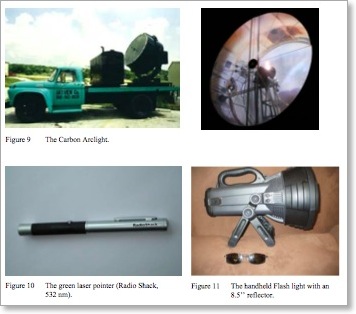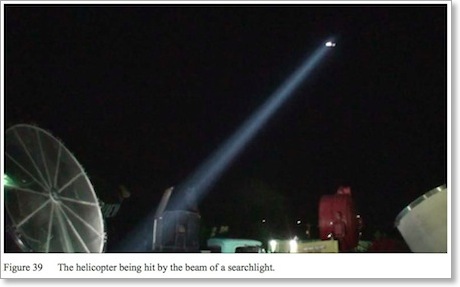In February 2009, researchers from TNO (the Netherlands Organisation for Applied Scientific Research) conducted tests in San Antonio, Texas, commisioned by the Dutch civil aviation authority Inspectie Verkeer en Waterstaat (equivalent to the U.S. FAA). The goal was to assess the effects of distraction, glare, and flashblindness on a helicopter pilot and his observer passenger.
The result was that searchlights were deemed to “cause no concern” outside of the area immediately around a runway, while even a small, U.S.-legal laser pointer was “unacceptably bright and caused serious glare.” Below are details taken from the study.
What light sources were used
First, the researchers aimed six types of high-intensity searchlights at the helicopter. These sources included a carbon arclight, an HID arclight, an HMI “Dominator”, and a 4K xenon Skytracker. Then, they also used a high-power handheld flashlight. Finally, for comparison they aimed a 3.5mW green laser pointer, purchased from RadioShack, at the helicopter.
Some of the lights were so large they were truck-mounted. The pen-sized laser pointer was by far the smallest source:

Searchlight and high-power flashlight effects
At distances from 200 to 500 meters, the helicopter pilot "never experienced any adverse effects of the light beams, and had no problems reading his instruments or viewing outside.... The pilot showed no signs of irritation and did not frown or look away or close his eyelids.... The amount of glare was minimal and had no effect on the ability of the pilot and experimenters to view the instruments in the cockpit and the outside world immediately surrounding the light source."
Laser effects
The 3.5mW laser pointer had a very different effect: "When hit by the laser pointer it was impossible for the observers to perceive details in the outside world. Both the pilot and the [observer passenger] found the impact of the laser pointer unacceptable. All observers felt the need to close their eyes to avoid looking into the beam. None of the other tested high intensity light sources produced any glare effects remotely comparable to that of the green laser pointer." [bold emphasis added, here and below]
In addition, the laser pointer caused flashblindness and afterimages, while the searchlights did not.
Gradual vs. sudden onset
The searchlight sources were always visible from the air. Pilots knew they were flying into the beams. The light gradually increased in size and brightness as the helicopter approached: “While approaching a searchlight it mostly appeared similar or even less in brightness to other city lights or car lights, and was therefore hard to distinguish from these. As a result, the high intensity searchlights tested in this study will not induce any adverse visual effects when they are not pointed directly at an airplane.”
In contrast, the laser beam was not seen until it was almost at the helicopter. “The laser beam was generally an unexpected insult, thus causing additional startle."

Study conclusions
“In normal use, broadband high intensity light sources pointing in navigable airspace, whether stationary or moving, cause no concern for aviation safety outside the [FAA’s] Laser Free Zone [around runways]. Outside the Laser Free Zone, pilots may experience glare and distraction when a high intensity light beam is intentionally tracking the canopy of the aircraft. Distraction may also occur when the high intensity light is the only bright light source in its environment.”
“The visual impact of a green laser pointer was more serious than expected. The light was unacceptably bright and caused serious glare at a distance of about 500 meters. At this distance it also elicited brief afterimages. The laser pointer could not be seen when its beam did not hit the eye.”
“We conclude that there is no need to restrict broadband high intensity light sources pointing in navigable airspace anywhere outside the Laser Free Zone. Intentionally tracking aircraft with a high intensity light, and especially with lasers, should be prohibited.”
Source
Toet, A., van der Leden, N. & Alferdinck, J.W.A.M. (2009). The outdoor use of lasers and other high intensity light sources in relation to air traffic safety (Report TNO-DV 2009 C264). Soesterberg, The Netherlands: TNO Defense, Security and Safety.
The complete technical report is available on the Files and Documents page.
